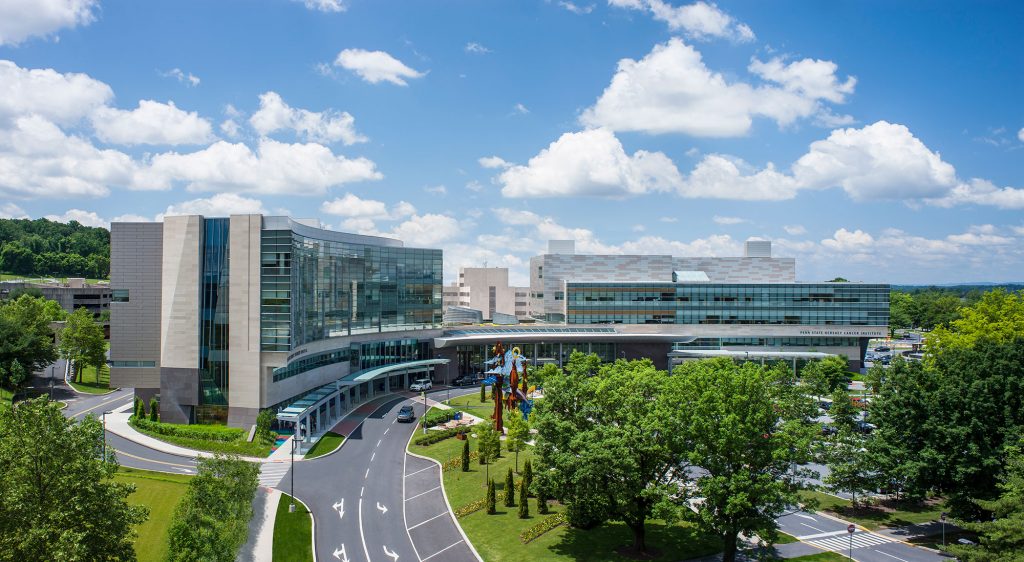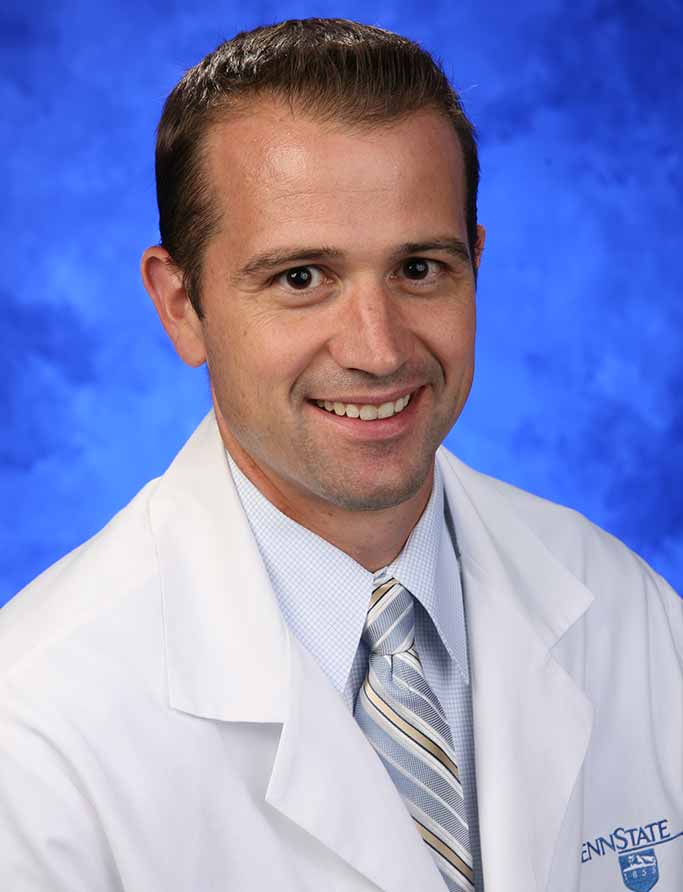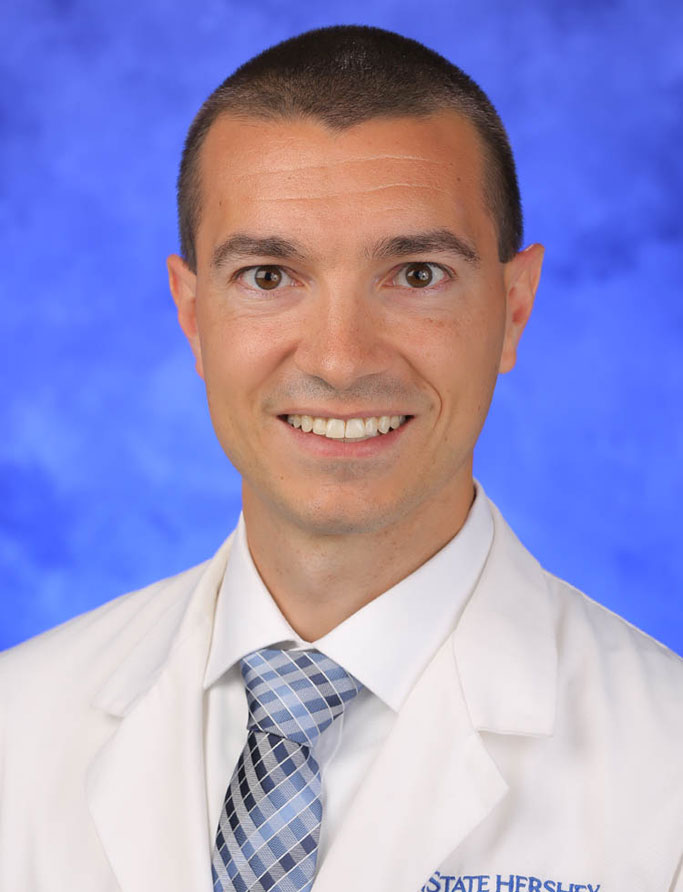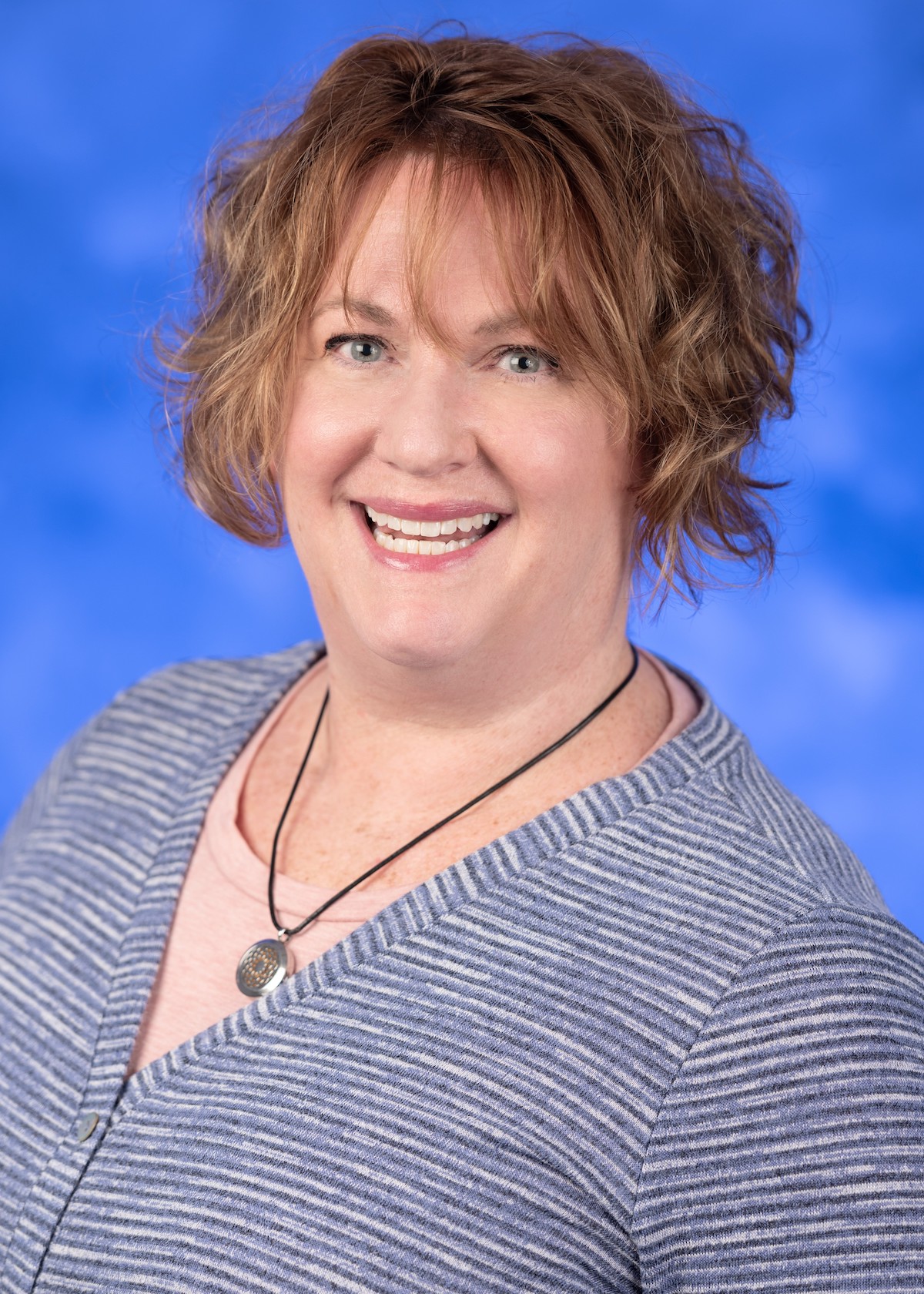Jump to topic
Search
Program Details
Penn State Health Milton S. Hershey Medical Center is a modern facility with more than 625 beds that provides a range of primary to quaternary medical services to a large catchment area in rural central Pennsylvania, spanning from Pittsburgh to Philadelphia. Patients present with a broad variety of problems, ranging from common everyday orthopaedic conditions to the most complicated of injuries shuttled to the Level I trauma center by the institution’s helicopter transport units.
The Orthopaedic Residency consists of eight clinical services that encompass all of the recognized areas of subspecialty orthopaedic practice, each represented by fellowship-trained faculty members. A senior and junior resident are paired on each of the services; in addition to the high priority given to teaching by the faculty members, the pairing of residents encourages mentoring and camaraderie. Additional clinical rotations include emergency and inpatient consultation services providing firsthand exposure to the common challenges of a contemporary orthopaedic practice. Outpatient practice is located in the Penn State Bone and Joint Institute, with musculoskeletal practitioners in orthopaedics, rheumatology, radiology, metabolic bone disease, pain management, physical medicine and therapy services.
A regular morning conference schedule provides a didactic session each day prior to the commencement of activity in the operating room. Conferences range from weekly grand rounds to a rotation of specific subspecialty conferences, an operative indications conference, monthly confidential peer review conference, an interdisciplinary tumor board and a core basic science curriculum. This strong program is supplemented by an array of service-specific meetings and a monthly journal club.
The Musculoskeletal Research Laboratory provides a unique opportunity to study musculoskeletal disease from an interdisciplinary perspective. Faculty expertise includes bone and cartilage cell biology, molecular biology, experimental biomechanics and computational finite element analysis. Research activities range from cell and tissue culture to in vivo animal models and biomechanical studies supported by both servohydraulic materials testing equipment as well as computational finite element modeling. Each resident is afforded unlimited access to the Musculoskeletal Research Laboratory, its faculty and its resources. The resident is expected to participate in an investigative project that provides an introduction to critical scientific thinking as well as a foundation for a lifetime of analysis of the published orthopaedic literature.
Learn More about the Residency
General Application Information
Applications for the Orthopaedic Residency must be made through Electronic Residency Application Services (ERAS).
Applicants must submit a completed ERAS application, including:
- USMLE scores
- Three or more letters of recommendation (at least one from an orthopaedic physician who can provide an assessment of the applicant’s potential as a future orthopaedic surgeon)
- Personal statement
- Medical school transcript
- Dean’s letter
Applications and Interview Process
The highly competitive program receives over 900 applications per year. Applicants are encouraged to begin the process early. Applications open to programs on Sept. 27. Ideally, candidates’ ERAS Application should be complete by this date.
Once the program’s review and selection process is complete, invitations for interviews will be extended via ERAS email.
Interviews will be held in person. There will be two separate interview days offered, with the choice of an a.m. session or a p.m. session. Approximately 30 candidates will be interviewed each day. Candidates will be interviewed by clinical faculty, basic science faculty and senior residents. There will also be unstructured time to talk casually with both residents and faculty.
A social will also be held on the evening between the two interview dates. This is not a sit-down dinner, and no RSVPs are needed. Please come and go as your travel plans allow.
Virtual Tour
Penn State Health
Penn State Health is a multi-hospital health system serving patients and communities across 29 counties of Pennsylvania. Its mission is to improve health through patient care, research, education and community outreach.
In December 2017, the system partnered with Highmark Health to facilitate creation of a value-based, community care network in the region. The shared goal of Highmark and Penn State Health is to ensure patients in the community are within:
- 10 minutes of a Penn State Health primary care provider
- 20 minutes of Penn State Health specialty care
- 30 minutes of a Penn State Health acute care facility
Learn more about Penn State Health

Penn State Health Children’s Hospital (left), Penn State Health Milton S. Hershey Medical Center (center) and Penn State Cancer Institute (right)
Penn State Health Milton S. Hershey Medical Center
500 University Dr., Hershey, Pa., 17033 (Derry Township, Dauphin County)
- The health system’s 647-bed flagship teaching and research hospital
- The only medical facility in Pennsylvania accredited as both an adult and a pediatric Level I (highest-level) trauma center
- Dedicated surgical, neuroscience, cardiovascular, trauma and medical intensive care units
- Accredited Life Lion critical-care transport providing more than 1,100 helicopter and approximately 750 ground ambulance transports per year
- More than 1,300 faculty members and more than 650 residents and fellows
- Approximately 29,000 admissions, 73,000 emergency department visits, 1.1 million outpatient visits and 33,000 surgical procedures annually
- Designated as a Magnet hospital since 2007
Learn more about Milton S. Hershey Medical Center
Penn State Health Children’s Hospital
600 University Dr., Hershey, Pa. 17033 (Derry Township, Dauphin County)
- An eight-story, 263,000-square-foot-facility built in 2013 and expanded in 2020
- 146 licensed pediatric beds, 18 acute care beds and a 56-bed neonatal intensive care unit
- Level IV (highest-level) neonatal intensive care unit
- Level I quaternary (highest-level) pediatric intensive care unit
- Level I (highest-level) pediatric trauma center designation
- Intermediate care unit
- Dedicated pediatric operating rooms
- More than 150,000 pediatric outpatient visits and approximately 5,000 pediatric patient discharges annually
Welcome to Hershey
More About Hershey
Interested in learning more about living and working in Hershey, Pa.? See details here:
Wellness, including emotional, spiritual, social and physical health, is a crucial component to training and to becoming a professional, compassionate and resilient physician. Self-care is a skill which must be continually practiced and reinforced. Penn State College of Medicine and Penn State Health are committed to addressing wellness among residents and fellows, with multiple resources readily available.
Institutional resources
- Visit BeWell – a health program designed to support Penn State Health employees
- See Penn State College of Medicine wellness resources here
- Employee Health Care Concierge and Case Management Service
- Partners in Medicine
Moving to a new city with your family does not have to be stressful. Residency programs have assisted many significant others with finding employment. There is also a GME-Wide Partners in Medicine (PIM) group that offers networking opportunities as well as various social and community oriented activities. - The Doctors Kienle Center for Humanistic Medicine
- Active and easily accessed Office of Professional Mental Health
Graduate medical education resources
Institutional Resources
Penn State Health and Penn State College of Medicine celebrate, embrace and support the diversity of all patients, faculty, staff, students and trainees.
Office for Diversity, Equity and Inclusion
In keeping with this, Penn State Health has an active Office for Diversity, Equity and Inclusion with various programs, networks and resource groups, including:
- Talks and lectures on diversity, equity and inclusion through the Inclusion Academy
- Regular events on topics such as eradicating racism and creating a culture of inclusiveness
- Many Business Employee Resource Groups (BERGs), including:
- Disability Business Employee Resource Group
- Interfaith Business Employee Resource Group
- LGBTQ+ Business Employee Resource Group
- Military and Veterans Business Employee Resource Group
- Multicultural Business Employee Resource Group
- NextGen Business Employee Resource Group
Learn more about the Penn State Health Office for Diversity, Equity and Inclusion
Learn more about the College of Medicine’s Office for Diversity, Equity and Belonging
Office for Culturally Responsive Health Care Education
The vision at Penn State College of Medicine and Penn State Health is to equip learners with the knowledge, skills and attitudes they will need to provide culturally excellent health care and research for an increasingly diverse U.S. population. The Office for Culturally Responsive Health Care Education was formed to help meet that goal.
Learn more about the Office for Culturally Responsive Health Care Education
Office for a Respectful Learning Environment
In addition, the institution does not tolerate discrimination, biases, microaggression, harassment or learner mistreatment of any kind, and any concerns are immediately addressed by the Office for a Respectful Learning Environment.
Learn more about the Office for a Respectful Learning Environment
Network of Under-represented Residents and Fellows
The Network of Under-represented Residents and Fellows (NURF) is a group of diverse residents and fellows representing all specialties. NURF’s goal is to promote cultural diversity in the residency programs through community involvement, mentorship with diverse faculty, professional networking and support for the recruitment of diverse medical students into the residency programs.
NURF is sponsored by the Penn State College of Medicine Graduate Medical Education Office and the Penn State Health Office for Diversity, Equity and Inclusion.
Mailing Address
Department of Orthopaedics and Rehabilitation
Attn: Lynne Hamann
Penn State Health Milton S. Hershey Medical Center
EC089
30 Hope Dr., Building A
P.O. Box 859
Hershey, PA 17033
General Contact Information
Phone: 717-531-4833
Fax: 717-531-0498
Curriculum Details and Rotations
The PGY-1 rotations are based upon educational requirements established by The American Board of Orthopaedic Surgery (ABOS) for board certification. These requirements include:
- A minimum of three months of structured education in surgery, to include:
- Multisystem trauma
- Plastic surgery/burn care
- Intensive care
- Pediatric surgery
- Vascular surgery
- A minimum of one month of structured education in at least three of the following:
- Emergency medicine
- Medical/cardiac intensive care
- Internal medicine
- Neurology
- Neurological surgery
- Rheumatology
- Anesthesiology
- Musculoskeletal imaging
- Rehabilitation
- A maximum of six months of orthopaedic surgery.
During an orthopaedic month, PGY-1 residents will complete a two-week health systems rotation.
The American Board of Orthopaedic Surgery (ABOS) requires that orthopaedic education in PGY-2 through PGY-5 must be broadly representative of the entire field of orthopaedic surgery.
The minimum distribution of educational experience must include:
- 12 months of adult orthopaedics
- 12 months of fractures/trauma
- Six months of children’s orthopaedics
- Six months of basic and/or clinical specialties
The Orthopaedic Residency at Penn State Health has developed the following rotation schedule for the PGY-2 through PGY-5 years in accordance with ABOS guidelines.
PGY-2
- Sports
- Emergency department rotation
- Hip and knee joint arthroplasty
- Spine
PGY-3
- Foot and ankle
- Pediatric orthopaedics/orthopaedic musculoskeletal oncology
- Trauma
- Hand
- Elbow/shoulder
PGY-4
- Trauma
- Pediatric orthopaedics/orthopaedic musculoskeletal oncology
- Foot and ankle
- Spine
- Shoulder/elbow
PGY-5
- Trauma
- Hip and knee joint arthroplasty
- Sports
- Hand
The goal of the Adult Reconstruction Service is to provide the resident with an educational experience that maximizes the opportunity to understand, evaluate, and treat orthopaedic adult reconstructive injuries.
This is achieved by combining a structured study program that utilizes an extensive recommended reading list with a clinical experience that has an appropriate balance between office evaluation and surgical treatment of total joint related injuries.
Junior- and senior-level residents rotate through the Adult Reconstruction Service for three-month blocks and assume responsibility based upon demonstrated knowledge, previous experience and clinical skills.
At the conclusion of the residency rotation on the Foot and Ankle Service, the graduate is expected to be proficient in the management of foot and ankle problems encountered in the subspecialty practice of orthopaedic foot and ankle reconstruction.
It is important to recognize that competency as a physician extends beyond medical knowledge and direct patient care. Therefore, evaluations will include not only these competencies, but also demonstration of abilities in medical knowledge and patient care, interpersonal and communication skills, professionalism, practice-based learning and improvement and systems-based practice.
The primary goal of the Foot and Ankle Service is to provide the resident with an educational experience that maximizes the opportunity to understand, evaluate, and treat orthopaedic foot and ankle conditions. This is achieved by combining a structured study program that utilizes an extensive recommended reading list with a clinical experience that has an appropriate balance between office evaluation and surgical treatment of foot and ankle related conditions.
Junior- and senior-level residents rotate through the Foot and Ankle Service for three-month blocks and assume responsibility based upon demonstrated knowledge, previous experience and clinical skills.
At the conclusion of the residency rotation on the Hand Service, the graduate is expected to be proficient in the management of hand problems encountered in the general practice of orthopaedics and plastic surgery.
It is important to recognize that competency as a physician extends beyond medical knowledge and direct patient care. Therefore, evaluations for the Hand Service will include not only these competencies, but also demonstration of abilities in medical knowledge and patient care, interpersonal and communication skills, professionalism, practice-based learning and improvement, and systems-based practice.
At the start of the rotation, the resident must contact the appropriate administrative assistant to schedule a beginning, mid-rotation and end-of-rotation evaluation.
The goal of the Hand Service is to provide the resident with an educational experience that maximizes the opportunity to understand, evaluate, and treat hand conditions. This is achieved by combining a structured study program that utilizes an extensive recommended reading list with a clinical experience that has an appropriate balance between office evaluation and surgical treatment of hand related conditions. Junior- and senior-level residents rotate through the Hand Service for three-month blocks and assume responsibility based upon demonstrated knowledge, previous experience, and clinical skills.
At the conclusion of the residency rotation on the Hip and Knee Joint Arthroplasty Service, the graduate is expected to be proficient in the management of adult reconstructive problems and their associated rehabilitation encountered in the general practice of orthopaedics.
It is important to recognize that competency as a physician extends beyond medical knowledge and direct patient care. Therefore, evaluations for the Sports Medicine Service will include not only these competencies, but also demonstration of abilities in medical knowledge and patient care, interpersonal and communication skills, professionalism, practice-based learning and improvement, and systems-based practice.
At the start of the rotation, the resident must contact the appropriate administrative assistant to schedule a beginning, mid-rotation, and end-of-rotation evaluation.
At the conclusion of the residency rotations on the orthopaedic Musculoskeletal Oncology Service, the graduate is expected to be proficient in the management of musculoskeletal oncology conditions encountered in the general practice of orthopaedics.
It is important to recognize that competency as a physician extends beyond medical knowledge and direct patient care. Therefore, evaluations for the Musculoskeletal Oncology Service will include not only these competencies, but also demonstration of abilities in medical knowledge and patient care, interpersonal and communication skills, professionalism, practice-based learning and improvement and systems-based practice.
The goal of the Musculoskeletal Oncology Service is to provide a well-rounded learning experience for the resident staff through a combination of clinical, surgical and didactic experiences. The service allows a truly multidisciplinary approach to the evaluation, diagnosis and treatment of patients with benign, malignant and metastatic neoplasms of the musculoskeletal system. The educational goal of the service is to educate orthopaedic surgery residents in the appropriate diagnosis and management of neoplastic processes of the musculoskeletal system. This includes primary malignant and benign bone tumors, metastatic bone tumors, benign and malignant soft tissue tumors and metabolic processes.
At the start of the rotation, the resident must contact the appropriate administrative assistant to schedule a beginning, mid-rotation and end-of-rotation evaluation.
At the conclusion of the residency rotation on the Orthopaedic Traumatology Service, the graduate is expected to be proficient in the management of orthopaedic trauma problems encountered in the general practice of orthopaedics.
It is important to recognize that competency as a physician extends beyond medical knowledge and direct patient care. Therefore, evaluations for the Orthopaedic Trauma Service will include not only these competencies, but also demonstration of abilities in medical knowledge and patient care, interpersonal and communication skills, professionalism, practice-based learning and improvement, and systems-based practice.
At the start of the rotation, the resident must contact the trauma administrative assistant to schedule a beginning, mid-rotation and end-of-rotation evaluation.
At the conclusion of the residency rotation on the Pediatric Orthopaedics Service, the graduate is expected to be proficient in the management of pediatric orthopaedic conditions and their associated rehabilitation encountered in the general practice of orthopaedics.
It is important to recognize that competency as a physician extends beyond medical knowledge and direct patient care. Therefore, evaluations for the Pediatric Orthopaedic Service will include not only these competencies, but also demonstration of abilities in medical knowledge and patient care, interpersonal and communication skills, professionalism, practice-based learning and improvement and systems-based practice.
At the conclusion of the residency rotation on the Shoulder and Elbow Service, the graduate is expected to be proficient in the management of shoulder and elbow conditions problems in the general practice of orthopaedics.
It is important to recognize that competency as a physician extends beyond medical knowledge and direct patient care. Therefore, evaluations for the Shoulder and Elbow Service will include not only these competencies, but also demonstration of abilities in medical knowledge and patient care, interpersonal and communication skills, professionalism, practice-based learning and improvement and systems-based practice.
The goal of the Shoulder and Elbow Service is to provide the resident with a comprehensive learning experience that maximizes the opportunity to understand, evaluate and treat orthopaedic shoulder and elbow injuries. This is achieved by combining a structured study program that utilizes an extensive recommended reading list with clinical experience that has an appropriate balance between office evaluation and surgical treatment of shoulder and elbow injuries. Junior- and senior-level residents rotate through the Shoulder and Elbow Service for three-month blocks and assume responsibility based upon demonstrated knowledge, previous experience and clinical skills.
It is recognized that advanced competence in shoulder and elbow surgery implies an additional year of specialized training. The objectives of shoulder and elbow training in this orthopaedic training program are two-fold: first, the preparation of resident for such specialized training; and second, clinical competence in common community shoulder and elbow procedures.
At the conclusion of the residency rotations on the Spine Service, the graduate is expected to be proficient in care of spine problems and their associated rehabilitation as might be encountered in the general practice of orthopaedics.
It is important to recognize that competency as a physician extends beyond medical knowledge and direct patient care. Therefore, evaluations for the spine service will include not only those competencies specific for each subspecialty such as medical knowledge, but also demonstration of abilities in practice-based learning, interpersonal communication skills, professionalism, patient care and systems-based practice.
The overall goal of the adult Spine Service is to provide the resident with an educational experience that maximizes the opportunity to understand, evaluate and treat conditions that affect the spine. This is achieved by combining a structured study program that utilizes an extensive recommended reading list with a clinical experience that has an appropriate balance between office and emergency room evaluation and surgical treatment of conditions of the spine. Junior- and senior-level residents rotate through the adult Spine Service for two- to three-month blocks and assume responsibility based upon demonstrated knowledge, previous experience and clinical skills.
Prior to the beginning of the rotation, each resident must contact the appropriate administrative assistant to obtain a reading list and to schedule a beginning, mid-rotation and end-of-rotation evaluation.
At the conclusion of the residency rotation on the Sports Medicine Service, the graduate is expected to be proficient in the management of sports medicine problems encountered in the general practice of orthopaedics.
It is important to recognize that competency as a physician extends beyond medical knowledge and direct patient care. Therefore, evaluations for the Sports Medicine Service will include not only these competencies, but also demonstration of abilities in medical knowledge and patient care, interpersonal and communication skills, professionalism, practice-based learning and improvement and systems-based practice.
The goal of the Sports Medicine Service is to provide the resident with an educational experience that maximizes the opportunity to understand, evaluate, and treat orthopaedic sports medicine injuries. This is achieved by combining a structured study program that utilizes an extensive recommended reading list with a clinical experience that has an appropriate balance between office evaluation and surgical treatment of sports related injuries. Junior- and senior-level residents rotate through the Sports Medicine Service for three-month blocks and assume responsibility based upon demonstrated knowledge, previous experience and clinical skills.
Resident Honors and Recognitions
Penn State College of Medicine and Penn State Health Milton S. Hershey Medical Center accept ongoing nominations for the Exceptional Moments in Teaching award.
The award, given monthly by the Office for a Respectful Learning Environment, accepts nominations from College of Medicine students who are invited to submit narratives about faculty members, residents, fellows, nurses or any other educators who challenge them and provide an exceptional learning experience. See more about the award here.
Previous nominees from the Orthopaedic Residency are listed here. Click the + next to a nominee name to read their nominator’s comments.
The annual Resident/Fellow Research Day is held each year (with exception of during the COVID-19 pandemic) on and around the Penn State Health Milton S. Hershey Medical Center campus.
The intent of the event is to provide an opportunity for residents and fellows to showcase their research accomplishments to their peers in other clinical departments, as well as their colleagues in the basic sciences.
Learn more about Resident/Fellow Research Day here.
Previous presentations from the Orthopaedic Residency are listed here.
Latest News from Orthopaedics






